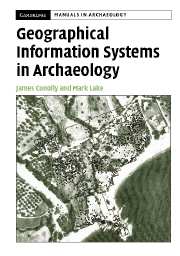Book contents
- Frontmatter
- Contents
- List of figures
- List of tables
- List of boxes
- Acknowledgements
- 1 INTRODUCTION AND THEORETICAL ISSUES IN ARCHAEOLOGICAL GIS
- 2 FIRST PRINCIPLES
- 3 PUTTING GIS TO WORK IN ARCHAEOLOGY
- 4 THE GEODATABASE
- 5 SPATIAL DATA ACQUISITION
- 6 BUILDING SURFACE MODELS
- 7 EXPLORATORY DATA ANALYSIS
- 8 SPATIAL ANALYSIS
- 9 MAP ALGEBRA, SURFACE DERIVATIVES AND SPATIAL PROCESSES
- 10 REGIONS: TERRITORIES, CATCHMENTS AND VIEWSHEDS
- 11 ROUTES: NETWORKS, COST PATHS AND HYDROLOGY
- 12 MAPS AND DIGITAL CARTOGRAPHY
- 13 MAINTAINING SPATIAL DATA
- Glossary
- References
- Index
12 - MAPS AND DIGITAL CARTOGRAPHY
Published online by Cambridge University Press: 05 June 2012
- Frontmatter
- Contents
- List of figures
- List of tables
- List of boxes
- Acknowledgements
- 1 INTRODUCTION AND THEORETICAL ISSUES IN ARCHAEOLOGICAL GIS
- 2 FIRST PRINCIPLES
- 3 PUTTING GIS TO WORK IN ARCHAEOLOGY
- 4 THE GEODATABASE
- 5 SPATIAL DATA ACQUISITION
- 6 BUILDING SURFACE MODELS
- 7 EXPLORATORY DATA ANALYSIS
- 8 SPATIAL ANALYSIS
- 9 MAP ALGEBRA, SURFACE DERIVATIVES AND SPATIAL PROCESSES
- 10 REGIONS: TERRITORIES, CATCHMENTS AND VIEWSHEDS
- 11 ROUTES: NETWORKS, COST PATHS AND HYDROLOGY
- 12 MAPS AND DIGITAL CARTOGRAPHY
- 13 MAINTAINING SPATIAL DATA
- Glossary
- References
- Index
Summary
Introduction
Cartographers have long recognised the influence that maps have on the shaping of spatial consciousness (Monmonier 1991; Wood 1992; Lewis and Wigen 1997). The purpose of this chapter is to explore the way maps, whether paper or digital, may be used to present spatial information and to highlight some design principles to maximise their effectiveness at this task. In doing so we describe a range of mapping techniques appropriate for the different sorts of data routinely handled by archaeologists. We also consider some major cartographic principles and design conventions that help make maps effective communication devices, and discuss the growing importance of the Internet and interactive mapping for the publication of spatial data.
Designing an effective map
As defined in Chapter 2, maps are traditionally divided into two categories: topographic and thematic. The former term describes maps that contain general information about features of the Earth's surface, whereas thematic maps are limited to single subjects, such as soils, geology, historic places, or some other single class of phenomena. Both types of map must contain some basic pieces of information so that the reader is able to comprehend and contextualise the data that is being presented. The most basic of these, without which a map is difficult if not impossible to understand, are: (i) a title; (ii) a scale; (iii) a legend and (iv) an orientation device, such as a north arrow (Table 12.1).
- Type
- Chapter
- Information
- Geographical Information Systems in Archaeology , pp. 263 - 279Publisher: Cambridge University PressPrint publication year: 2006
- 1
- Cited by

